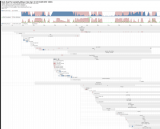本文用off-cpu火焰图分析一个程序的延迟(主要在拿锁上),找出来瓶颈,并消除的故事。本文非常值得一读,但是阅码场没有足够的时间将其翻译为中文,希望童鞋们直接读英文。
The Setup
As a performance engineer at MemSQL, one of my primary responsibilities is to ensure that customer Proof of Concepts (POCs) run smoothly. I was recently asked to assist with a big POC, where I was surprised to encounter an uncommon Linux performance issue. I was running a synthetic workload of 16 threads (one for each CPU core). Each one simultaneously executed a very simple query (select count(*) from t where i > 5) against a columnstore table.
In theory, this ought to be a CPU bound operation since it would be reading from a file that was already in disk buffer cache. In practice, our cores were spending about 50% of their time idle
In this post, I’ll walk through some of the debugging techniques and reveal exactly how we reached resolution.
What were our threads doing?
After confirming that our workload was indeed using 16 threads, I looked at the state of our various threads. In every refresh of myhtopwindow, I saw that a handful of threads were in theDstate corresponding to “Uninterruptible sleep”:

Why were we going off CPU?
At this point, I generated anoff-cpu flamegraphusing Linuxperf_eventsto see why we entered this state.Off-CPUmeans that instead of looking at what is keeping the CPU busy, you look at what is preventing it from being busy by things happening elsewhere (e.g. waiting for IO or a lock). The normal way to generate these visualizations is to useperf inject -s, but the machine I tested on did not have a new enough version ofperf. Instead I had to use anawkscriptI had previously written:
$ sudoperfrecord --call-graph=fp -e 'sched:sched_switch' -e 'sched:sched_stat_sleep' -e 'sched:sched_stat_blocked' --pid $(pgrep memsqld | head -n 1) -- sleep 1
[ perf record: Woken up 1 times to write data ]
[ perf record: Captured and wrote 1.343 MB perf.data (~58684 samples) ]
$ sudoperfscript -f time,comm,pid,tid,event,ip,sym,dso,trace -i sched.data | ~/FlameGraph/stackcollapse-perf-sched.awk | ~/FlameGraph/flamegraph.pl --color=io --countname=us >off-cpu.svg
Note: recording scheduler events viaperf recordcan have a very large overhead and should be used cautiously in production environments. This is why I wrap theperf recordaround asleep 1to limit the duration.
In an off-cpu flamegraph, the width of a bar is proportional to the total time spent off cpu. Here we see a lot of time is spent inrwsem_down_write_failed.
From the repeated calls torwsem_down_read_failedandrwsem_down_write_failed, we see that culprit wasmmapcontending in the kernel on themm->mmap_semlock:
down_write(&mm->mmap_sem);
ret = do_mmap_pgoff(file, addr, len, prot, flag, pgoff,&populate);
up_write(&mm->mmap_sem);
This was causing everymmapsyscall to take 10-20ms (almost half the latency of the query itself). MemSQL was so fast that that we had inadvertently written a benchmark for Linuxmmap!

The fix was simple — we switched from usingmmapto using the traditional filereadinterface. After this change, we nearly doubled our throughput and became CPU bound as we expected:
For more information and discussion around Linux performance,check out the original post on my personal blog.
Download MemSQL Community Edition to run your own performance tests for free today:memsql.com/download
Alex Reece is a systems and performance engineer. He believes in active benchmarking, root cause analysis, and fast code.
-
cpu
+关注
关注
68文章
10922浏览量
213277 -
Linux
+关注
关注
87文章
11354浏览量
210657 -
SQL
+关注
关注
1文章
775浏览量
44301
原文标题:用off-cpu火焰图调查Linux性能问题
文章出处:【微信号:LinuxDev,微信公众号:Linux阅码场】欢迎添加关注!文章转载请注明出处。
发布评论请先 登录
相关推荐
中国锂离子电池原材料市场调查分析报告2008-2009版
全志Tina中使用perf分析CPU使用率
火焰识别
Linux CPU的性能应该如何优化
疫情之下,中国LED显示屏市场活力调查分析
火焰图系列之使用火焰图隐藏功能提高绘制精度

火焰图:全局视野的Linux性能剖析
基于linux eBPF的进程off-cpu的方法

Linux问题分析与性能优化

Linux问题故障定位的小技巧





 如何使用OFF-CPU火焰图调查分析Linux性能问题概述
如何使用OFF-CPU火焰图调查分析Linux性能问题概述












评论